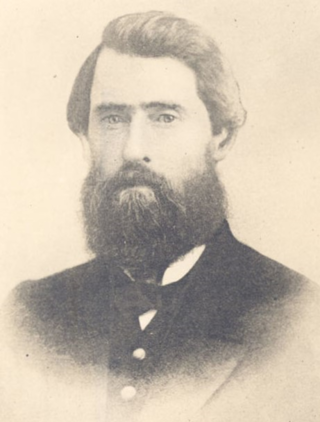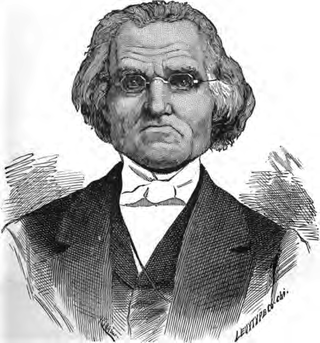Related Research Articles

Newfields is a town in Rockingham County, New Hampshire, United States. The population was 1,769 at the 2020 census. The primary village in town, where 378 people resided at the 2020 census, is defined as the Newfields census-designated place (CDP) and is located along New Hampshire Route 85 and the Squamscott River. It is a quaint village of handsome old houses.

Jason Lee was a Canadian Methodist Episcopalian missionary and pioneer in the Pacific Northwest. He was born on a farm near Stanstead, Quebec.

Willbur Fisk was a prominent American Methodist minister, educator and theologian. He was the first President of Wesleyan University.

James Whitford Bashford was a bishop of the Methodist Episcopal Church in the United States and the first bishop of the Methodist Episcopal Church in China.

John Christian Keener was an American bishop of the Methodist Episcopal Church, South, an author and an editor, and the superintendent of C.S.A. chaplains west of the Mississippi River during the American Civil War. He wrote several books on theology and edited the New Orleans Christian Advocate, a weekly Methodist newspaper sponsored by Methodist conferences in Louisiana and various nearby states in the late-19th and early-20th century. A collection of Keener's papers, available at the Stuart A. Rose Manuscript, Archives, and Rare Book Library at Emory University, include correspondence and military orders related to the return of property to the Methodist Church, South, after the war.
Gouverneur Wesleyan Seminary was an American school located in Gouverneur, St. Lawrence County, New York The seminary was operated in the 19th century by the Black River Conference of the Methodist Episcopal Church.

David Leslie was an American missionary and pioneer in what became the state of Oregon. A native of New Hampshire, he joined Jason Lee as a missionary at the Methodist Mission in the Oregon Country in 1836. In that region he participated in the early movement to start a government and his home was used for some of these meetings. With the closing of the mission he became a founder of the city of Salem, Oregon, and board member of the Oregon Institute, which later became Willamette University.

Erastus Wentworth was an educator, a Methodist Episcopal minister, and a missionary to Fuzhou, China.
Fairfield Academy was an academy that existed for nearly one hundred years in the Town of Fairfield, Herkimer County, New York.

The Rev. Dr. George McKendree Steele, D.D., LL.D. was an American educator and Methodist minister, president of Lawrence University in Appleton, Wisconsin from 1865 to 1879. He was the author of the 1876 pamphlet The Currency Question – regarded as a major statement of the philosophy of the Greenback movement – and was a Greenback Party nominee for Congress and other public office.

William Rice (1821–1897) was a Methodist Episcopal minister, author, and from 1861 to his death in 1897, the President and Executive Director of the Springfield City Library Association. He was an important public figure in nineteenth-century Springfield, Massachusetts.

William Rice was a Massachusetts businessman and public servant, a member of the Massachusetts House of Representatives and a Registrar of deeds and Treasurer for Hampden County, Massachusetts.

Charles Francis Rice was a prominent minister and author. He was a member of the New England Conference of the Methodist Episcopal Church for 50 years, serving as a District Superintendent for five years and as President of the Massachusetts Federation of Churches for 10 years.

Harriet Merrick Warren was an American editor. She was also an untiring worker in the Woman's Foreign Missionary Society, its first recording secretary, and for years, president of the New England Branch. Warren is remembered as a "major leader of 'Woman's Work for Woman'" movement.

Richard Sutton Rust was an American Methodist preacher, abolitionist, educator, writer, lecturer, secretary of the Freedmen's Bureau, and founder of the Freedmen's Aid Society. He also helped found multiple educational institutions including his namesake Rust College in Holly Springs, Mississippi, the oldest historically black United Methodist-related college.

Susan J. Swift Steele was an American social reformer. She was affiliated with the Woman's Foreign Missionary Society of the Methodist Episcopal Church, Woman's Christian Temperance Union (WCTU), and the Newton, Massachusetts Wesleyan Home, among other organizations.

Hannah Maynard Pickard was a 19th-century American school teacher, preceptress, and author. She wrote extensively for the Sabbath School Messenger, and some for the Guide to Holiness, and other periodicals. She was the author of two novels, several editions of which were published, Procrastination and The Widow's Jewels.
Caroline Laura Rice was an American teacher, writer, composer, and social reformer.
References
- 1 2 3 Fritz Wetherbee: Wesleyan Academy, Newfields, 2017
- ↑ Massachusetts Board of Education; George A. Walton (1877), "Report on Academies: Wesleyan Academy", Annual Report...1875-76, Boston – via Internet Archive
{{citation}}: CS1 maint: location missing publisher (link) - ↑ George Adams (1853). "Education in Massachusetts: Incorporated Academies". Massachusetts Register. Boston: Printed by Damrell and Moore.
- Simpson, Matthew, ed. (1880). Cyclopaedia of Methodism (PDF) (Revised ed.). Philadelphia: Louis H. Everts.